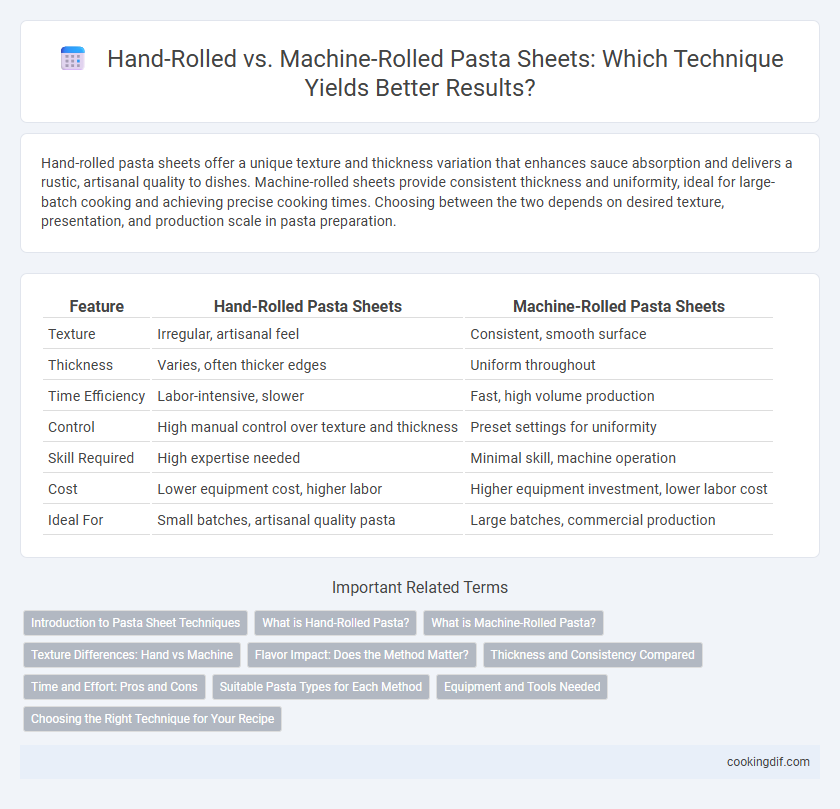Hand-rolled pasta sheets offer a unique texture and thickness variation that enhances sauce absorption and delivers a rustic, artisanal quality to dishes. Machine-rolled sheets provide consistent thickness and uniformity, ideal for large-batch cooking and achieving precise cooking times. Choosing between the two depends on desired texture, presentation, and production scale in pasta preparation.
Table of Comparison
| Feature | Hand-Rolled Pasta Sheets | Machine-Rolled Pasta Sheets |
|---|---|---|
| Texture | Irregular, artisanal feel | Consistent, smooth surface |
| Thickness | Varies, often thicker edges | Uniform throughout |
| Time Efficiency | Labor-intensive, slower | Fast, high volume production |
| Control | High manual control over texture and thickness | Preset settings for uniformity |
| Skill Required | High expertise needed | Minimal skill, machine operation |
| Cost | Lower equipment cost, higher labor | Higher equipment investment, lower labor cost |
| Ideal For | Small batches, artisanal quality pasta | Large batches, commercial production |
Introduction to Pasta Sheet Techniques
Hand-rolled pasta sheets offer a traditional texture with slight thickness variations that enhance sauce absorption, emphasizing artisanal quality. Machine-rolled sheets provide uniform thickness and consistency, ideal for delicate pasta types like lasagna or ravioli. Mastering both techniques enables versatility in homemade pasta dishes, balancing texture control with efficiency.
What is Hand-Rolled Pasta?
Hand-rolled pasta involves manually stretching and flattening the dough using a rolling pin or by hand, resulting in a thicker, more textured sheet ideal for rustic dishes like pappardelle or lasagna. This traditional technique allows precise control over thickness and texture, producing pasta with a tender bite and better sauce adhesion due to its uneven surface. Compared to machine-rolled pasta, hand-rolled dough captures an artisanal quality that enhances flavor absorption and showcases craftsmanship in Italian culinary traditions.
What is Machine-Rolled Pasta?
Machine-rolled pasta is created by passing dough through a pasta machine that evenly flattens the sheet to a consistent thickness, ensuring uniform cooking and texture. This technique allows for faster production and greater precision compared to hand-rolled sheets, making it ideal for both commercial settings and home cooks seeking efficiency. The mechanical process often results in a smoother surface, which pairs well with delicate sauces that cling easily to pasta strands.
Texture Differences: Hand vs Machine
Hand-rolled pasta sheets exhibit a slightly uneven texture with subtle thickness variations, creating a tender bite and enhanced sauce absorption. Machine-rolled sheets produce uniform thickness and smooth surfaces, resulting in a consistent, firmer texture ideal for layered dishes like lasagna. The choice between hand and machine rolling directly impacts pasta mouthfeel and overall culinary experience.
Flavor Impact: Does the Method Matter?
Hand-rolled pasta sheets often have a rougher texture that helps sauce cling better, enhancing flavor absorption and overall taste experience. Machine-rolled sheets, while consistently thin and even, may lack the slight irregularities that trap sauce and intensify flavor. The method influences the pasta's mouthfeel and sauce interaction, ultimately affecting the flavor profile.
Thickness and Consistency Compared
Hand-rolled pasta sheets often vary in thickness due to manual pressure, resulting in a more artisanal texture with slight irregularities. Machine-rolled pasta sheets provide consistent thickness, ideal for evenly cooked dishes and professional-quality results. The uniformity achieved by machines enhances pasta's structural integrity and can improve sauce adherence compared to hand-rolled variants.
Time and Effort: Pros and Cons
Hand-rolled pasta sheets require significant time and manual effort, producing a more delicate texture and allowing precise thickness control. Machine-rolled sheets save time and reduce physical strain, offering uniform thickness but sometimes sacrificing artisanal texture. Choosing between hand-rolled and machine-rolled pasta depends on the balance between desired quality and available preparation time.
Suitable Pasta Types for Each Method
Hand-rolled pasta sheets offer superior flexibility, making them ideal for delicate types such as tortellini and ravioli that require precise thickness control and subtle texture. Machine-rolled sheets provide uniform thickness and are better suited for robust pasta like lasagna and fettuccine, where consistency ensures even cooking and structural integrity. Selecting the appropriate method enhances the pasta's final texture and cooking performance, tailored to the specific shape and filling requirements.
Equipment and Tools Needed
Hand-rolled pasta sheets require a rolling pin and a flat surface, allowing for precise thickness control and a rustic texture, while machine-rolled sheets necessitate a pasta roller with adjustable settings to ensure consistent thickness and smoothness. Hand-rolling demands more physical effort and skill, but offers flexibility in shaping dough, whereas machine rollers streamline the process, speeding up production and improving uniformity. Selecting the appropriate equipment depends on volume, desired texture, and the artisan's preference for traditional craftsmanship versus efficiency.
Choosing the Right Technique for Your Recipe
Hand-rolled pasta sheets offer precise thickness control and a rustic texture ideal for delicate recipes like ravioli or lasagna, where a softer bite is preferred. Machine-rolled sheets provide consistent, uniform thickness and faster production, making them suitable for recipes requiring even cooking such as fettuccine or tagliatelle. Selecting between hand-rolled and machine-rolled techniques depends on desired texture, cooking time, and recipe complexity to achieve optimal pasta quality.
Hand-rolled vs machine-rolled for sheet technique Infographic

 cookingdif.com
cookingdif.com